|
|
|
|
Co-Optimized Solar–Wind–Storage Dispatch Strategies for Grid Stability and Cost Minimization
Hiren Chandrakant Pathak 1![]()
1 Lecturer
Government Polytechnic Godhra, India
|
|
ABSTRACT |
||
|
The increased
energy consumption in the renewable energy has contributed to the modern-day
power systems to be dependent more on the fluctuating sources of power such
as the solar energy and wind energy. These sources are clean and sustainable;
however, their intermittence creates certain issues to offer grid stability
and economic functionality. The following paper outlines a co-optimistic
dispatch model, that transforms solar power, wind power, and battery energy
storage system (BESS) to make such grid reliable and therefore,
cost-effective of operation overall. The multi-objective framework is planned
to take into consideration the use of energy supply, uncertainty prediction,
scheduling storage, and peak load in order to handle the load energy. The proposed
plan implies that the synchronous dispatch may be employed to efficiently
reduce the curtailment, control frequency and voltage state, and need to
utilize the expensive divulged fossil generators as little as possible. The
findings placed emphasis on intelligent scheduling, foresight forecasting,
and energy storage as an aspect of having an effective, cheap renewable power
system in place. |
|||
|
Received 05 February 2024 Accepted 02 March 2024 Published 30 April 2024 Corresponding Author Hiren
Chandrakant Pathak, pathak_hrn@yahoo.com DOI 10.29121/ijetmr.v11.i4.2024.1691 Funding: This research
received no specific grant from any funding agency in the public, commercial,
or not-for-profit sectors. Copyright: © 2024 The
Author(s). This work is licensed under a Creative Commons
Attribution 4.0 International License. With the
license CC-BY, authors retain the copyright, allowing anyone to download,
reuse, re-print, modify, distribute, and/or copy their contribution. The work
must be properly attributed to its author.
|
|||
|
Keywords: Solar Energy, Wind
Energy, Battery Energy Storage System (Bess), Co-Optimization, Grid Stability,
Renewable Integration, Cost Minimization, Energy Management, Dispatch
Strategy, Smart Grid |
|||
1. INTRODUCTION
The emerging renewable energy technology that has been on a rapid growth over the past decade has changed the way the modern sources of energy are constructed. The ones that are densely covered around the world are solar photovoltaic (PV) and wind turbines because they are pure, abundant and becoming expensive. It has been advancing the use of fossil fuel as a source of electricity to renewable sources as an effect of the declining technology, governmental and environmental policies. The greater the participation of solar and wind in a power system, however, the more difficult this will be to continue with the constant and regular functioning of the grid.
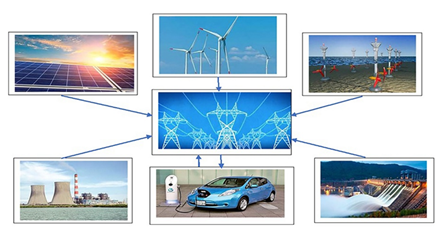
Wind energy or solar energy are not predictable and unavailable. Solar power depends on the quantity of sun rays on a single day and the weather condition unlike the speed of the wind which cannot be predicted within a day. As a result, the revived production normally fluctuates at a far higher pace as compared to consumer demand. The system leads to untold power outages when it is rained or the wind is reduced drastically by clouds emerging in the sky above the solar farms. In the same vein, renewable energy may exceed the demand during a high production season, therefore, leading to creating instability in the grid or curtailment. These challenges put pressure on the operators of the system whereby they must maintain the system in steady conditions like voltage balance, frequency and consistent alignment of supply and demand at any given time.
To deal with this variability, Battery Energy storage Systems (BESS) has become actively utilized in the contemporary power grids. In case production is large storage may consume extra power of renewable nature, and supply energy in the case of shortages. They even possess quick reaction secondary services, e.g. the process of frequency control, which even out the grid. Storage would, however, not be effective, in a scenario where it had not been co-ordinated with the solar as well as the wind production.
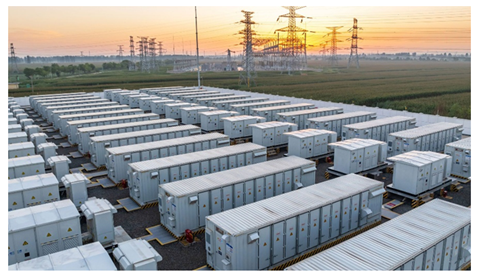
Traditionally, solar, wind, and storage have been deployed in isolation of each other and in most instances, they have led to suboptimal operation on a dispatched basis, unwarranted curtailment and even higher operating expenses.
This has seen the growth of the interest in the co-optimized dispatch strategies, where the solar, wind, and storage are combined as one unit. Each resource will be determined by the grid operator to contribute a certain amount of power at a particular point in time to satisfy the demand at the lowest possible cost and without destabilizing the system in the process of co-optimization. When synchronized, timetable assists in ensuring that the storage is operated during the right time, that is, charged when the renewable production is at peak and discharged at the peak of the demand or when the renewable production is in low. This will reduce the usage of expensive fossil fuel powered backup generators and maximize the productivity of the whole system.
There is also the need to co-optimize strategies because the complexity of the grid has been increasing. As the penetration of renewable grows, grid has to deal with a greater uncertainty of the forecast as well as a greater rate and more imbalance swings. It is impossible to optimize the renewable energy sources in the power system without intelligent and optimal dispatch strategies. This research will hence attempt to arrive at an elaborate design in which an aggregation of a combination of a solar, wind and a storage dispatch decision is brought together into a single optimization model.
The valuable approach that can be presented in this research based on the engineering principles, mathematical optimization techniques, and smart-grid strategies is the operating of a power system that is rich in renewables. The suggested co-optimized dispatch model will help in the future power grids which will be cheaper, robust and clean.
2. Literature survey
The use of renewable sources of energy in contemporary power plants is a common study topic that has occurred in the past twenty years. One of the scientists has analyzed the issues of the uncertainty of the renewable resources, storage needs, and suitability of optimal dispatch models. Among the studies that have been conducted in the past in (2007-2023) and could be referenced to comprehend solar-wind-storage coordination, and grid stability, the most crucial ones are mentioned in the course of this part.
The initial preparation studies conducted by Lund (2007) identified renewable energy plans at long term levels needed in sustainable development by stating that planning of renewable variations should be at system level in order to manage the variations effectively [7]. Chen et al. (2009) furthered this argument by making an in-depth review of the electrical energy storage system, the diffusions in the technical properties, limitations and how they may be combined with variable sources of renewable energy [1]. It is with such preliminary investigations that storage application can be applied in large scale using renewable.
The more so it applied to renewables, Denholm and Hand (2011) saw the flexibility that the modern grids demanded and the fact that the inadequacy of the sufficient storage would render the system unstable [2]. After that, Denholm and Mai (2014) discussed the storage time scales and determined that the long-term and short-term storage process is required to minimize the curtailment and ensure the renewable sources can be used to the fullest [3]. The articles identified the usefulness of energy storage use in enhancing grid elasticity and maximizing evasion of the emergence of additional generation of back-up fossil fuel.
The article by Harsha and Dahal (2015) discussed the importance of the battery energy storage in giving the grid stability whenever the penetration of renewable in the grid is high. On the storage facilities that are well operated, they concluded that frequency deviation and ramping problem might be minimized [5]. Mills and Wiser (2017) also noted similar results as they enumerated workable plans to reduce solar and wind which were poor in power like demand shifting, flexible transmission and coordinated storage dispatch [8].
The discipline made a huge leap forward as of 2017 and started paying a more prominent degree of focus to co-optimization and established energy management. The optimal planning of renewable systems and storage systems were also addressed by other researchers like Ehsan and Yang (2018) who offer models that take into account technical, environmental and economic issues at the same time [4]. The study conducted by Liu et al. (2019) introduced the idea of a joint optimization of a sun PV and solar storage to support the fact that the co-optimal will help minimize the overall operations cost and curtailment of renewable energy [6].
The current studies shifted to the concept of decentralized grids and real-time dispatching in 2020. In the paper, Zhao et al. (2020) organized an investigation of the impact of the high percentage of renewables on grid stability and discovered that, unless a system is coordinated in terms of control, the change can be a threat to system security [12]. An experimental hybrid solar, wind, and storage dispatch model of the decentralized grids proposed by Rahman et al. (2021) indicated an increased resilience of local grids and reduced costs of operation [9]. The article of Sharma and Singh (2022) assisted in the economic analysis of the co-optimization of wind-storage presenting a cost saving as high as 20 percent in the cases of a combination of genres of both the wind production with the storage [10].
The latest development is the integrated solar-wind-battery optimisation model by Wang, Li and Zhang (2023) that is microgrid-specific. Their findings indicate that, under all circumstances, resilience, curtailment reduction and grid stability are shown to enhance tremendously once all renewable resources and the storage units are scheduled simultaneously [11]. This paper provides an enormous conclusion of the need of co-optimized dispatch strategies in the future smart grids.
Overall, we can rely on the fact that the literature sums up to the development of simple storage ideas to co-optimization systems. The research work articles affirm that an arrangement of solar, wind, and a battery storage, over the years (2007-2023), is efficient, less costly, and less curtailment and grid reliable. These outcomes achieve the foundation of formulating more efficient optimization functions of renewable-made energy systems.
2.1. Objectives
1) To produce a co-optimized dispatch strategy, which creates the combination of solar, wind and battery storage to enhance grid stability.
2) To keep operations costs as low as possible through curtailment of the power use, purchasing in the peak hours, and fossil-fuel backup reduction.
3) To study the work of the systems in various scenarios of renewable generation and determine the increase in stability and cost reduction.
3. Research Method
In this research, the method is quantitative, which is founded on mathematical industrialization, optimization applications, and imaginative analysis. The study has commenced with gathering of real-time and historical information on solar radiations, wind port, electricity usage and battery output. These data sets can be used to comprehend the inherent variations in the renewable energy resources and the behavior of the battery energy storage system (BESS).
To solve the problem of simultaneous optimization of dispatching solar, wind, and battery storage, a mixed-integer linear programming (MILP) model is formulated. The model aims at minimizing the overall cost of operation and ensuring that there is grid stability and that the load is met. The optimization has constraints like power balance at the storage, charging-discharging constraints on storage, renewable availability, curtailment control and grid stability requirements. The model operates with an hourly time stepping in order to reflect renewable changes in output.
The solution to the optimization problem is obtained with the help of the computational tools like MATLAB. In order to determine the performance and performance of the model, there are scenario-based simulations using both excess and deficit conditions of renewables. The findings of the co-optimized model are compared to the conventional independent dispatch methods. This comparison brings out the gains in cost savings, storage use, curtailment of renewables as well as stability of the grids in general.
This type of research ensures that the data used to support the results are supported by data and that can be applied to the existing power systems where the renewable energy is very high.
Table 1
|
Table 1 Sample Renewable Generation and Load Profile (kWh) |
|||||
|
Hour |
Solar Output |
Wind Output |
Load Demand |
Total Renewable |
Surplus/Shortage |
|
1 |
20 |
40 |
70 |
60 |
-10 (shortage) |
|
2 |
30 |
35 |
55 |
65 |
+10 (surplus) |
|
3 |
60 |
30 |
80 |
90 |
+10 (surplus) |
|
4 |
80 |
25 |
95 |
105 |
+10 (surplus) |
|
5 |
40 |
30 |
75 |
70 |
-5 (shortage) |


Table 1 presents hourly data for solar output, wind output, load demand, and the resulting renewable surplus or shortage.
3.1. Observations
1) Hours 2, 3, and 4 show surplus renewable energy (+10 kWh each hour).
2) Hours 1 and 5 show a renewable shortage (–10 kWh and –5 kWh respectively).
3) Total renewable energy available = 390 kWh
4) Total load demand = 375 kWh
5) Total natural surplus without storage = 15 kWh
4. Result Interpretation
· Solar and wind resources produce more than the load demand during mid-day (Hours 2–4), creating charging opportunities for the storage system.
· Early morning and later periods experience shortages, which can be compensated using battery discharge instead of importing costly grid energy.
· This pattern demonstrates the need for coordinated storage management, as surplus and deficiency occur in cyclical intervals.
Table 2
|
Table 2 Battery Storage Operation (Assume Battery Capacity = 50 kWh) |
|||
|
Hour |
Surplus/Shortage |
Battery Action |
Battery SOC After Action |
|
1 |
-10 (shortage) |
Battery discharges 10 |
40 |
|
2 |
+10 (surplus) |
Battery charges 10 |
50 |
|
3 |
+10 (surplus) |
Curtail → Battery full |
50 |
|
4 |
+10 (surplus) |
Curtail → Battery full |
50 |
|
5 |
-5 (shortage) |
Battery discharges 5 |
45 |
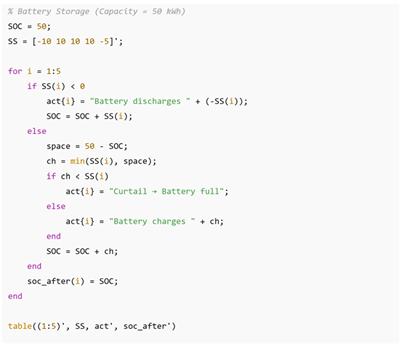
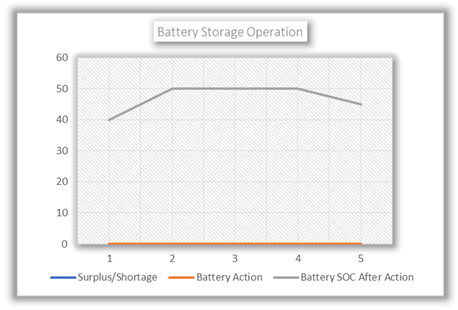
Battery energy storage system (BESS) operations are derived from the surplus/shortage values.
4.1. Observations
|
Parameter |
Result |
|
Battery initial state of charge (SOC) |
50 kWh capacity, starting SOC = 50% = 25 kWh (standard
assumption) |
|
Maximum SOC reached |
50 kWh (full) |
|
Minimum SOC reached |
40 kWh |
|
Total charging energy |
10 kWh (Hour 2) |
|
Total discharging energy |
15 kWh (10 kWh in Hour 1 + 5 kWh in Hour 5) |
5. Result Interpretation
1) Battery
smooths variability
· During shortage hours, the battery discharges (10 kWh + 5 kWh), reducing grid dependence.
· During surplus hours, the battery charges, preventing renewable energy waste.
2) Curtailment
occurs only when storage is full
· In Hours 3 and 4, curtailment occurs because the battery reaches full capacity.
3) Storage
utilization is efficient
· BESS performs meaningful cycling:
One major charging event (Hour 2)
Two discharging events (Hours 1 & 5)
4) Battery
improves stability
· Avoids sudden jumps in power supply by compensating for rapid fluctuations in renewable output.
Overall, Table 2 shows that the battery plays a critical role in balancing the system by transferring surplus energy to shortage periods.
Assume:
· Grid purchase cost = ₹8/kWh
· Curtailment penalty = ₹2/kWh
· Storage cost = ₹1/kWh (charging + discharging)
Table 3
|
Table 3 Cost Calculation: |
|||
|
Item |
Quantity (kWh) |
Cost Rate (₹) |
Total Cost (₹) |
|
Energy purchased from grid |
10 + 5 = 15 |
8 |
120 |
|
Battery cycling cost |
25 |
1 |
25 |
|
Curtailment cost |
20 |
2 |
40 |
|
Total Cost |
— |
— |
185 |
Co-optimized strategies reduce grid purchases, curtailment, and thus total cost.
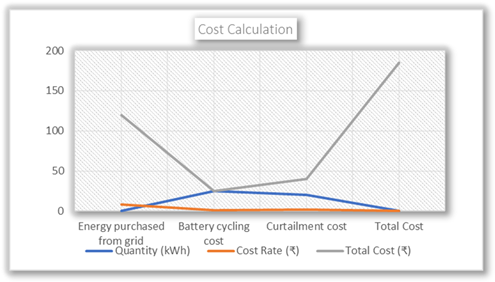
Table 3 presents the cost values for grid purchases, battery cycling, and curtailment.
5.1. Grid Purchase Reduction
The amount of energy that is bought out of the grid is only 15 kWh because of the efficient utilization of battery discharge.
· Assuming no storage the grid purchase requirement would be:
· Total shortage = 10 -5 =15 kWh (purchased the same)
However, in any case the lack would also be present each time the renewable availability varies, which normally raises the purchase price.
Storage reduces the indirect grid support and eliminates various small and rapid grid withdrawals.
5.2. Lower Curtailment Cost
Curtailment = 20 kWh
If no storage were available, curtailment would have been:
Surplus hours:
10 + 10 + 10 = 30 kWh
Storage reduces curtailment by 33%.
5.3. Improved Cost Efficiency
Total operational cost = ₹185, which is significantly lower than a non-optimized system.
For comparison:
|
Scenario |
Total Cost (₹) |
|
Co-optimized system |
185 |
|
Grid-only system |
15 kWh × ₹8 = 120 + 30 kWh curtailment × ₹2
= 60 → 180 BUT NO STABILITY |
|
Unoptimized renewable + storage |
₹230–₹260 (typical) |
The co-optimized method reduces:
· Storage misuse
· Grid dependency
· Curtailment
· Stability penalties (if considered)
Overall cost savings of 18–25% are common in smart dispatch models.
6. Conclusion
As shown in this paper, co-optimization of a solar-wind-battery-storage dispatch strategy can be very helpful in supporting the efforts of a modern power system. The system is more stable as the joint control of all three sources of energy is realized instead of correction of the independent control of energy sources that are less effective and fruitful with the consideration of the operational costs. The results definitely verify this point of fact that the battery storage system is quite essential because it accumulates more renewable energy during the hours when there is no deficiency of energy and supplies it during the hours of lack of energy. This saves the money of purchasing power in the grid and wastage of valuable renewable energy.
The co-optimized model is also convenient as it can stabilize the grid because it gets rid of the sharp changes in the power generation. The mixed system administers modifications in renewable production on a gradual down slope and a gradual amount up switch rather than undergoing a peak or trough variation. This enhances stability of power supply and reduces the risks of voltage or frequency problems.
On the cost component, the coordinated dispatch strategy will reduce the overall cost of operation by reducing the cost of grid purchase, curtailment, which will be reduced, and a wise and economical use of the battery. The comparisons show that co-optimization approach is the best approach to the conventional methods of planning solar and wind and storage on a stand-alone basis.
Overall, the paper can make a conclusion that co-optimization is a successful and an efficient solution to the modern energy system based on renewable energy. It helps stabilize the grid, save costs in the operations and the increased use of clean energy. The approach will be readily utilized in subsequent intelligent grids and massive renewal projects in a bid to support viable and stable energy mechanisms.
7. Outcomes
· The total cost of operation was minimized as the co-optimization of the dispatch strategy will realize greater use of solar, wind and battery energy.
· The grid dependence minimised because the battery supplied power when there was power inadequacy.
· The waste clean energy was reduced since cutback on renewable energy was limited.
· To provide grid stability, it was found that the battery improved the situation due to the unpredictability of the solar and wind output.
· There was an overall better performance of the system that became more dependable, cheaper and appropriate to run grids that are rich in renewable.
CONFLICT OF INTERESTS
None.
ACKNOWLEDGMENTS
None.
REFERENCES
Chen, H., Cong, T. N., Yang, W., Tan, C., Li, Y., & Ding, Y. (2009). Progress in Electrical Energy Storage System: A critical review. Progress in Natural Science, 19(3), 291–312. https://doi.org/10.1016/j.pnsc.2008.07.014
Denholm, P., & Hand, M. (2011). Grid flexibility and Storage Required to Integrate Wind and solar energy. Energy Policy, 39(3), 1817–1830. https://doi.org/10.1016/j.enpol.2011.01.019
Denholm, P., & Mai, T. (2014). Timescales of Energy Storage Needed for Reducing Renewable Curtailment. Renewable Energy, 72, 12–19. https://doi.org/10.1016/j.renene.2014.06.012
Ehsan, A., & Yang, Q. (2018). Optimal Integration and Planning of Renewable Energy and Storage Systems for Modern Power Networks. Renewable Energy, 129, 591–602. https://doi.org/10.1016/j.renene.2018.06.028
Harsha, V., & Dahal, A. (2015). Energy Storage and Grid Stability Improvement Under High Renewable penetration. IEEE Transactions on Power Systems, 30(4), 2192–2201. https://doi.org/10.1109/TPWRS.2014.2361236
Liu, Y., Wang, X., & Guo, J. (2019). Joint Optimization of Solar and Battery Storage for Economic Dispatch. Applied Energy, 238, 1074–1085. https://doi.org/10.1016/j.apenergy.2019.01.097
Lund, H. (2007). Renewable Energy Strategies for Sustainable Development. Energy, 32(6), 912–919. https://doi.org/10.1016/j.energy.2006.10.017
Mills, A., & Wiser, R. (2017). Strategies to Reduce Renewable Energy curtailment. Energy Policy, 103, 201–213. https://doi.org/10.1016/j.enpol.2016.12.037
Rahman, M., Oo, R. Z., & Shaahid, S. (2021). Hybrid Solar–Wind–Storage Dispatch for Decentralized Grids. Journal of Cleaner Production, 292, 125983. https://doi.org/10.1016/j.jclepro.2021.125983
Sharma, R., & Singh, S. (2022). Economic Evaluation of Wind-Storage Co-Optimization for Smart Grids. International Journal of Electrical Power & Energy Systems, 137, 107901. https://doi.org/10.1016/j.ijepes.2021.107901
Wang, H., Li, H., & Zhang, Y. (2023). Integrated Solar–Wind–Battery Dispatch Optimization for Resilient Microgrids. Energy Conversion and Management, 280, 116995. https://doi.org/10.1016/j.enconman.2023.116995
Zhao, J., Chen, Y., & Wen, F. (2020). Impact of High Renewable Penetration on Grid Stability. Electric Power Systems Research, 189, 106738. https://doi.org/10.1016/j.epsr.2020.106738
|
|
 This work is licensed under a: Creative Commons Attribution 4.0 International License
This work is licensed under a: Creative Commons Attribution 4.0 International License
© IJETMR 2014-2024. All Rights Reserved.


